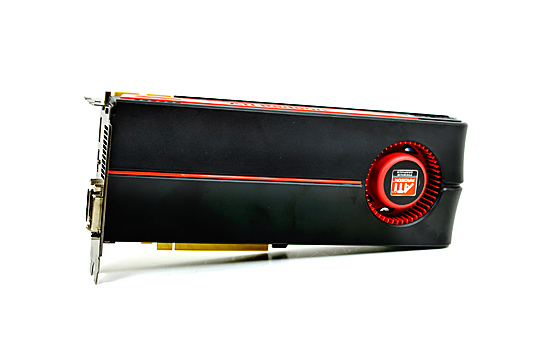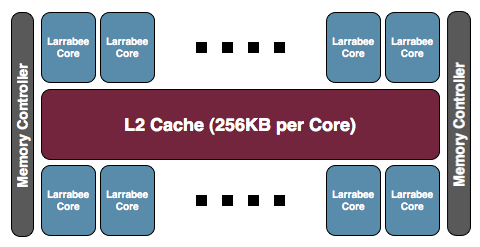Anand's Thoughts on Intel Canceling Larrabee Prime
by Anand Lal Shimpi on December 6, 2009 8:00 PM EST- Posted in
- GPUs
Larrabee is Dead, Long Live Larrabee
Intel just announced that the first incarnation of Larrabee won't be a consumer graphics card. In other words, next year you're not going to be able to purchase a Larrabee GPU and run games on it.
You're also not going to be able to buy a Larrabee card and run your HPC workloads on it either.
Instead, the first version of Larrabee will exclusively be for developers interested in playing around with the chip. And honestly, though disappointing, it doesn't really matter.

The Larrabee Update at Fall IDF 2009
Intel hasn't said much about why it was canceled other than it was behind schedule. Intel recently announced that an overclocked Larrabee was able to deliver peak performance of 1 teraflop. Something AMD was able to do in 2008 with the Radeon HD 4870. (Update: so it's not exactly comparable, the point being that Larrabee is outgunned given today's GPU offerings).
With the Radeon HD 5870 already at 2.7 TFLOPS peak, chances are that Larrabee wasn't going to be remotely competitive, even if it came out today. We all knew this, no one was expecting Intel to compete at the high end. Its agents have been quietly talking about the uselessness of > $200 GPUs for much of the past two years, indicating exactly where Intel views the market for Larrabee's first incarnation.
Thanks to AMD's aggressive rollout of the Radeon HD 5000 series, even at lower price points Larrabee wouldn't have been competitive - delayed or not.

I've got a general rule of thumb for Intel products. Around 4 - 6 months before an Intel CPU officially ships, Intel's partners will have it in hand and running at near-final speeds. Larrabee hasn't been let out of Intel hands, chances are that it's more than 6 months away at this point.
By then Intel wouldn't have been able to release Larrabee at any price point other than free. It'd be slower at games than sub $100 GPUs from AMD and NVIDIA, and there's no way that the first drivers wouldn't have some incompatibly issues. To make matters worse, Intel's 45nm process would stop looking so advanced by mid 2010. Thus the only option is to forgo making a profit on the first chips altogether rather than pull an NV30 or R600.
So where do we go from here? AMD and NVIDIA will continue to compete in the GPU space as they always have. If anything this announcement supports NVIDIA's claim that making these things is, ahem, difficult; even if you're the world's leading x86 CPU maker.
Do I believe the 48-core research announcement had anything to do with Larrabee's cancelation? Not really. The project came out of a different team within Intel. Intel Labs have worked on bits and pieces of technologies that will ultimately be used inside Larrabee, but the GPU team is quite different. Either way, the canceled Larrabee was a 32-core part.

A publicly available Larrabee graphics card at 32nm isn't guaranteed, either. Intel says they'll talk about the first Larrabee GPU sometime in 2010, which means we're looking at 2011 at the earliest. Given the timeframe I'd say that a 32nm Larrabee is likely but again, there are no guarantees.
It's not a huge financial loss to Intel. Intel still made tons of money all the while Larrabee's development was underway. Its 45nm fabs are old news and paid off. Intel wasn't going to make a lot of money off of Larrabee had it sold them on the market, definitely not enough to recoup the R&D investment, and as I just mentioned using Larrabee sales to pay off the fabs isn't necessary either. Financially it's not a problem, yet. If Larrabee never makes it to market, or fails to eventually be competitive, then it's a bigger problem. If heterogenous multicore is the future of desktop and mobile CPUs, Larrabee needs to succeed otherwise Intel's future will be in jeopardy. It's far too early to tell if that's worth worrying about.
One reader asked how this will impact Haswell. I don't believe it will, from what I can tell Haswell doesn't use Larrabee.
Intel has a different vision of the road to the CPU/GPU union. AMD's Fusion strategy combines CPU and GPU compute starting in 2011. Intel will have a single die with a CPU and GPU on it, but the GPU isn't expected to be used for much compute at that point. Intel's roadmap has the CPU and AVX units being used for the majority of vectorized floating point throughout 2011 and beyond.


Intel's vision for the future of x86 CPUs announced in 2005, surprisingly accurate
It's not until you get in the 2013 - 2015 range that Larrabee even comes into play. The Larrabee that makes it into those designs will look nothing like the retail chip that just got canceled.
Intel's announcement wasn't too surprising or devastating, it just makes things a bit less interesting.










75 Comments
View All Comments
Jedi2155 - Monday, December 7, 2009 - link
I'm with you on the network department as I absolutely love intel wireless chipsets over most of the other vendors as well as their wired Ethernet implementations.The0ne - Monday, December 7, 2009 - link
Also love Intel Networks but don't like their Server side at all. Didn't pan out so well and it was a rough time working with them (ServerWorks) at the time (10 years ago I believe).n7 - Sunday, December 6, 2009 - link
Yeah those SSDs they've made are just terrible...jeffrey - Sunday, December 6, 2009 - link
You bring-up some interesting points. I would like to add Itanium. Tukwila is running a little late just like all of the other members of the family.Anand, any chance of an in-depth status update of the Intel Itanium Architecture?
Taft12 - Monday, December 7, 2009 - link
Uhh, he DID include Itanium when he mentioned non-x86 CPUs.I don't know of Intel screwing up any networking business. Their ethernet cards are regarded as some of the best available.